Effects of Castor and Corn Biodiesel on Engine Performance and Emissions under Low-Load Conditions
Abstract
:1. Introduction
2. Methodology
2.1. Material and Biodiesel Fuel Production
2.2. Experimental Setup
2.3. Methodology
2.4. Properties of Biodiesel
3. Results
3.1. Emission Characteristics
3.1.1. HC Emissions Characteristics
3.1.2. CO Emissions Characteristics
3.1.3. NOx Emissions Characteristics
3.1.4. Particle Mass (PM) Characteristics
3.2. Performance Characteristics
3.2.1. Variation in Brake Thermal Efficiency
3.2.2. Brake-Specific Fuel Consumption
4. Conclusions
Author Contributions
Funding
Data Availability Statement
Conflicts of Interest
Nomenclature
| D100 | Pure diesel |
| B10 | 90% diesel + 10% biodiesel |
| B20 | 80% diesel + 20% biodiesel |
| KOH | Potassium hydroxide |
| HC | Hydrocarbon |
| CO | Carbon monoxide |
| NOX | Nitrogen oxide |
| PM | Particle mass |
| BTE | Brake Thermal Efficiency |
| BSFC | Brake-Specific Fuel Consumption |
| CRDI | Common rail direct injection |
| rpm | Revolutions per minute |
| DOC | Diesel oxidation catalyst |
| DPF | Diesel particulate filter |
References
- Dziubak, T.; Dziubak, S.D. A study on the effect of inlet air pollution on the engine component wear and operation. Energies 2022, 15, 1182. [Google Scholar] [CrossRef]
- Aminzadegan, S.; Shahriari, M.; Mehranfar, F.; Abramović, B. Factors affecting the emission of pollutants in different types of transportation: A literature review. Energy Rep. 2022, 8, 2508–2529. [Google Scholar] [CrossRef]
- Sun, C.; Xu, S.; Yang, M.; Gong, X. Urban traffic regulation and air pollution: A case study of urban motor vehicle restriction policy. Energy Policy 2022, 163, 112819. [Google Scholar] [CrossRef]
- Almetwally, A.A.; Bin-Jumah, M.; Allam, A.A. Ambient air pollution and its influence on human health and welfare: An overview. Environ. Sci. Pollut. Res. 2020, 27, 24815–24830. [Google Scholar] [CrossRef] [PubMed]
- Nadan, K. For My Family, No More Idling the Car; Korea Ministry of Environment (KOR): Sejong, Republic of Korea, 2017; Available online: https://www.me.go.kr/home/web/board/read.do?menuId=10525&boardMasterId=1&boardCategoryId=39&boardId=815190 (accessed on 27 February 2024).
- Zhang, Z.; Liu, H.; Li, Y.; Ye, Y.; Tian, J.; Li, J.; Xu, Y.; Lv, J. Research and optimization of hydrogen addition and EGR on the combustion, performance, and emission of the biodiesel-hydrogen dual-fuel engine with different loads based on the RSM. Heliyon 2024, 10, e23389. [Google Scholar] [CrossRef] [PubMed]
- Kalghatgi, G. Is it really the end of internal combustion engines and petroleum in transport? Appl. Energy 2018, 225, 965–974. [Google Scholar] [CrossRef]
- Palani, Y.; Devarajan, C.; Manickam, D.; Thanikodi, S. Performance and emission characteristics of biodiesel-blend in diesel engine: A review. Environ. Eng. Res. 2022, 27, 200338. [Google Scholar] [CrossRef]
- Kaushik, S.; Sati, V.; Kanojia, N.; Mehra, K.S.; Malkani, H.; Pant, H.; Gupta, H.; Singh, A.P.; Kumar, A.; Paul, A.R.; et al. Biodiesel a substitution for conventional diesel fuel: A comprehensive review. Adv. Mech. Eng. Sel. Proc. CAMSE 2020, 2021, 113–122. [Google Scholar]
- Mathew, G.M.; Raina, D.; Narisetty, V.; Kumar, V.; Saran, S.; Pugazhendi, A.; Sindhu, R.; Pandey, A.; Binod, P. Recent advances in biodiesel production: Challenges and solutions. Sci. Total Environ. 2021, 794, 148751. [Google Scholar] [CrossRef]
- Babadi, A.A.; Rahmati, S.; Fakhlaei, R.; Barati, B.; Wang, S.; Doherty, W.; Ostrikov, K.K. Emerging technologies for biodiesel production: Processes, challenges, and opportunities. Biomass Bioenergy 2022, 163, 106521. [Google Scholar] [CrossRef]
- Tanklevska, N.; Petrenko, V.; Karnaushenko, A.; Melnykova, K. World corn market: Analysis, trends and prospects of its deep processing. Agric. Resour. Econ. Int. Sci. E-J. 2020, 6, 96–111. [Google Scholar] [CrossRef]
- Hosseinzadeh-Bandbafha, H.; Nizami, A.-S.; Kalogirou, S.A.; Gupta, V.K.; Park, Y.-K.; Fallahi, A.; Sulaiman, A.; Ranjbari, M.; Rahnama, H.; Aghbashlo, M.; et al. Environmental life cycle assessment of biodiesel production from waste cooking oil: A systematic review. Renew. Sustain. Energy Rev. 2022, 161, 112411. [Google Scholar] [CrossRef]
- Panwar, N.L.; Shrirame, H.Y.; Bamniya, B.R. CO2 mitigation potential from biodiesel of castor seed oil in Indian context. Clean Technol. Environ. Policy 2010, 12, 579–582. [Google Scholar] [CrossRef]
- Osorio-González, C.S.; Gómez-Falcon, N.; Sandoval-Salas, F.; Saini, R.; Brar, S.K.; Ramírez, A.A. Production of biodiesel from castor oil: A review. Energies 2020, 13, 2467. [Google Scholar] [CrossRef]
- Mandal, A.; Cho, H.; Chauhan, B.S. Experimental investigation of multiple fry waste soya bean oil in an agricultural CI engine. Energies 2022, 15, 3209. [Google Scholar] [CrossRef]
- Chanakaewsomboon, I.; Moollakorn, A. Soap formation in biodiesel production: Effect of water content on saponification reaction. Int. J. Chem. Environ. Sci. 2021, 2, 28–36. [Google Scholar] [CrossRef]
- Chidambaranathan, B.; Gopinath, S.; Aravindraj, R.; Devaraj, A.; Krishnan, S.G.; Jeevaananthan, J.K.S. The production of biodiesel from castor oil as a potential feedstock and its usage in compression ignition Engine: A comprehensive review. Mater. Today Proc. 2020, 33, 84–92. [Google Scholar] [CrossRef]
- Zheng, F.; Cho, H. Combustion and Emission of Castor Biofuel Blends in a Single-Cylinder Diesel Engine. Energies 2023, 16, 5427. [Google Scholar] [CrossRef]
- Xue, J.; Grift, T.E.; Hansen, A.C. Effect of biodiesel on engine performances and emissions. Renew. Sustain. Energy Rev. 2011, 15, 1098–1116. [Google Scholar] [CrossRef]
- Hoang, A.T. Prediction of the density and viscosity of biodiesel and the influence of biodiesel properties on a diesel engine fuel supply system. J. Mar. Eng. Technol. 2021, 20, 299–311. [Google Scholar] [CrossRef]
- Razzaq, L.; Farooq, M.; Mujtaba, M.A.; Sher, F.; Farhan, M.; Hassan, M.T.; Soudagar, M.E.M.; Atabani, A.E.; Kalam, M.A.; Imran, M. Modeling viscosity and density of ethanol-diesel-biodiesel ternary blends for sustainable environment. Sustainability 2020, 12, 5186. [Google Scholar] [CrossRef]
- Islam, M.T.; Rashid, F.; Arefin, M.A. Numerical analysis of the performance and NOx emission of a diesel engine fueled with algae biofuel-diesel blends. Energy Sources Part A Recovery Util. Environ. Eff. 2021, 1–20. [Google Scholar] [CrossRef]
- Liu, X.; Wang, H.; Yao, M. Experimental and modeling investigations on soot formation of ethanol, n-butanol, 2,5-dimethylfuran, and biodiesel in diesel engines. Energy Fuels 2017, 31, 12108–12119. [Google Scholar] [CrossRef]
- Liu, X.; Wang, H.; Wang, X.; Zheng, Z.; Yao, M. Experimental and modelling investigations of the diesel surrogate fuels in direct injection compression ignition combustion. Appl. Energy 2017, 189, 187–200. [Google Scholar] [CrossRef]
- Jia, L.; Cheng, P.; Yu, Y.; Chen, S.-H.; Wang, C.-X.; He, L.; Nie, H.-T.; Wang, J.-C.; Zhang, J.-C.; Fan, B.-G.; et al. Regeneration mechanism of a novel high-performance biochar mercury adsorbent directionally modified by multimetal multilayer loading. J. Environ. Manag. 2023, 326, 116790. [Google Scholar] [CrossRef]
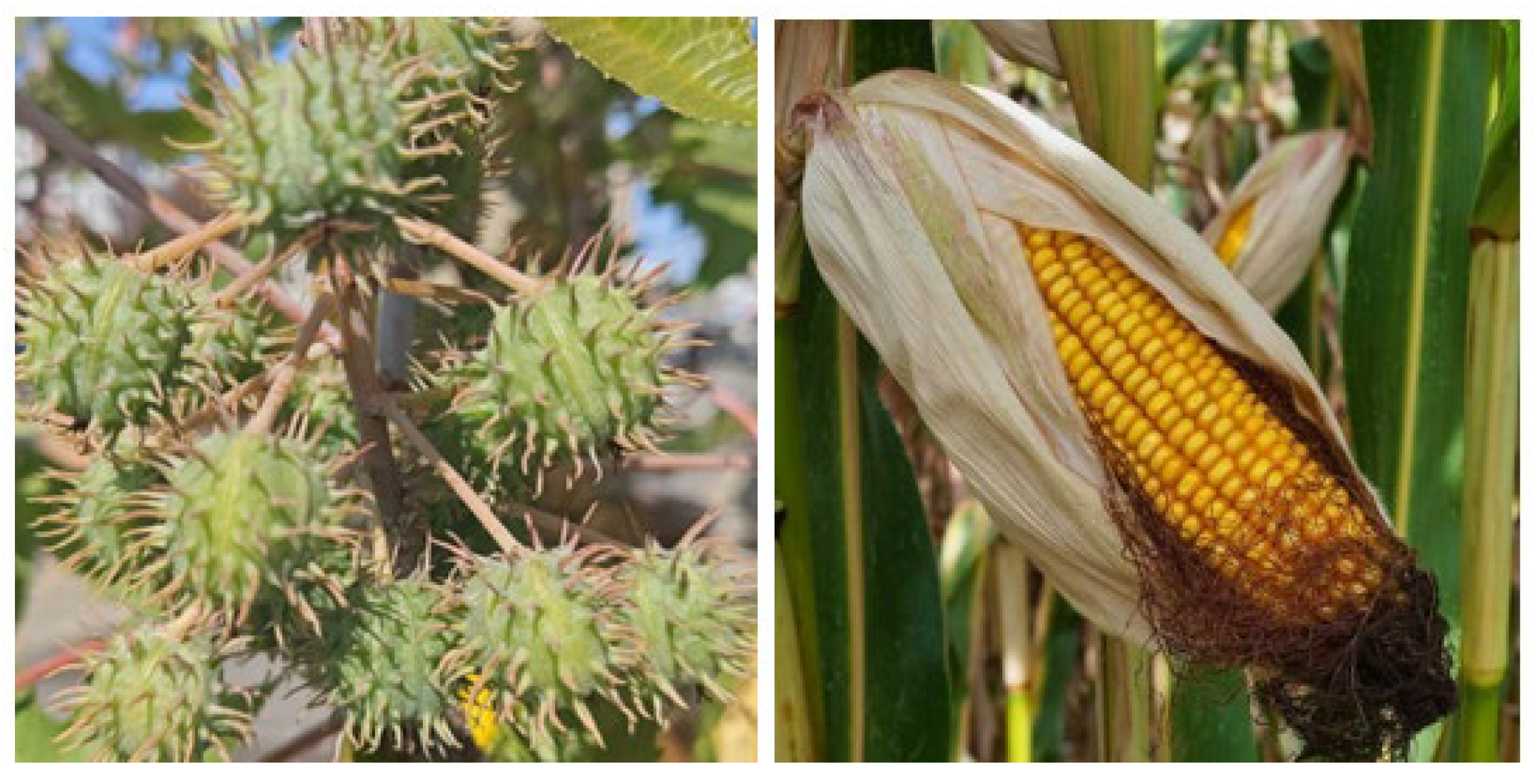
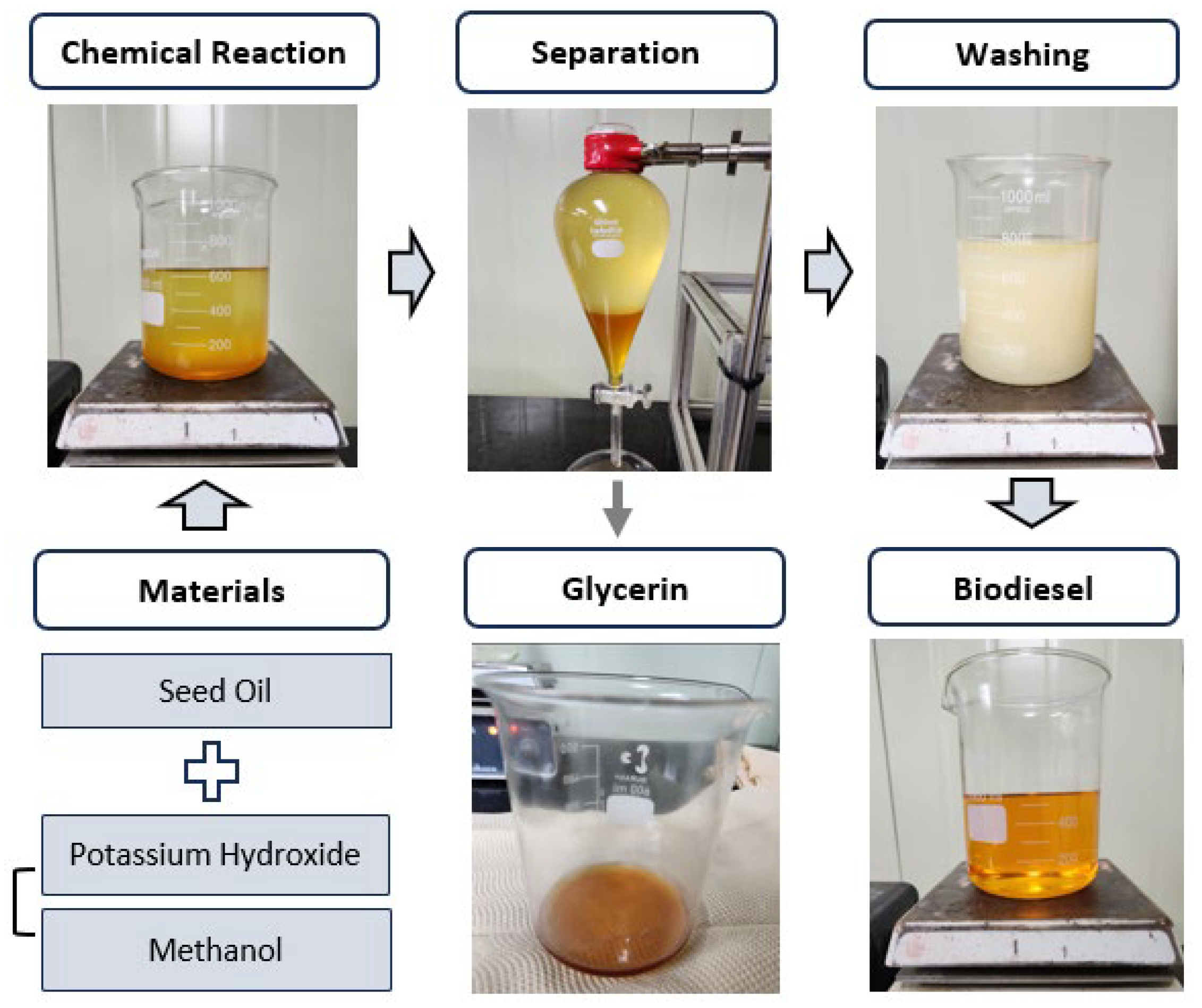

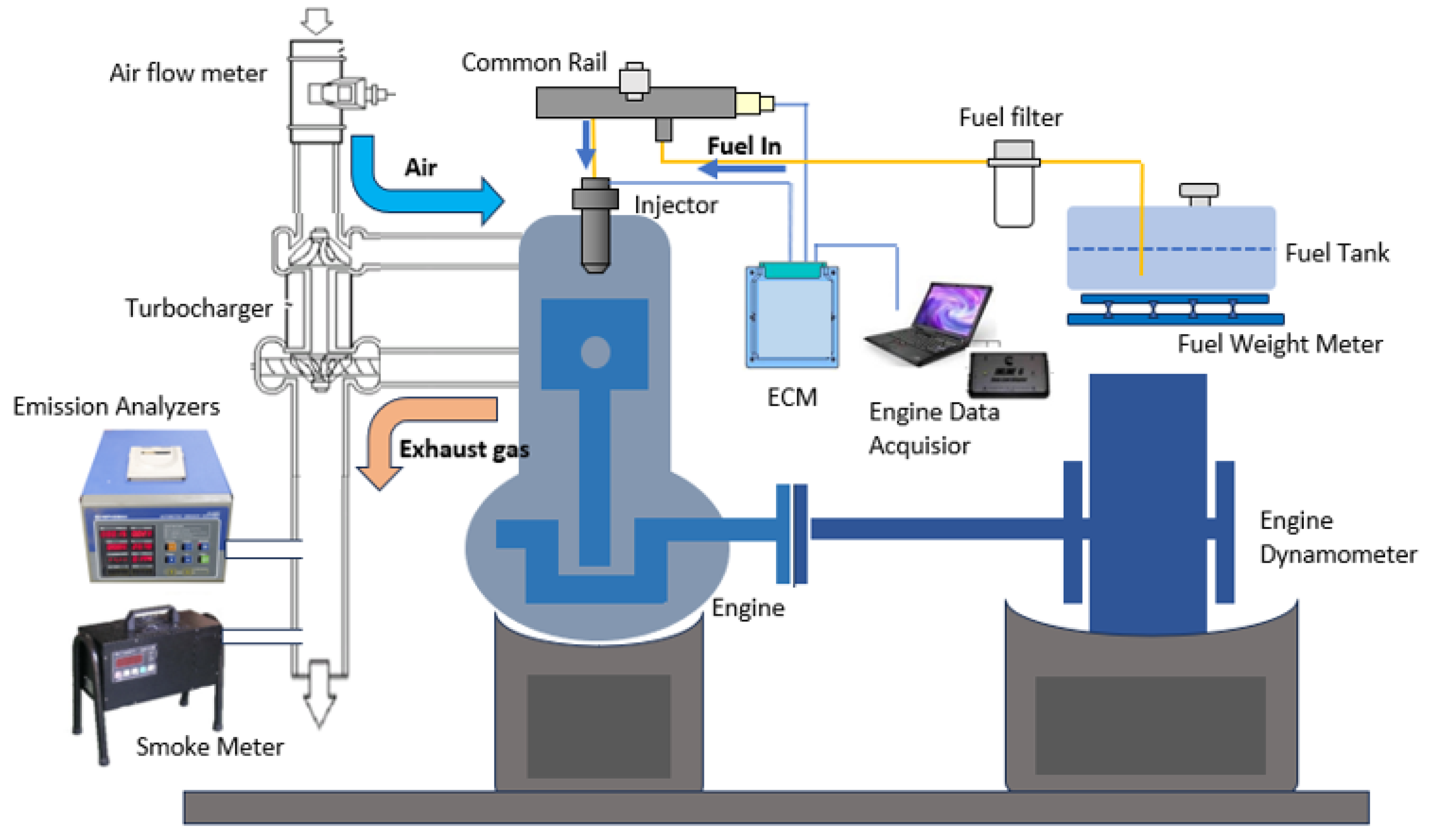

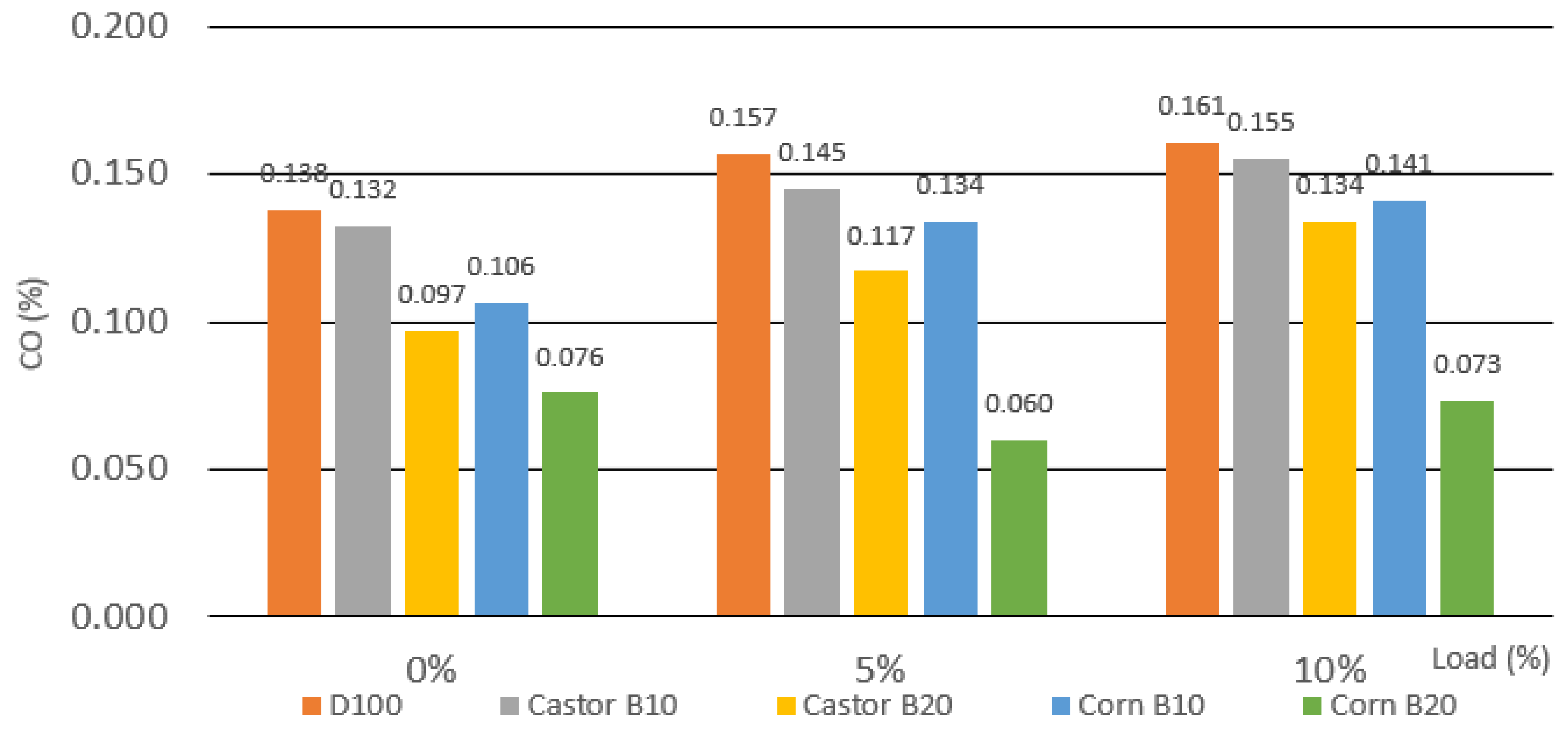
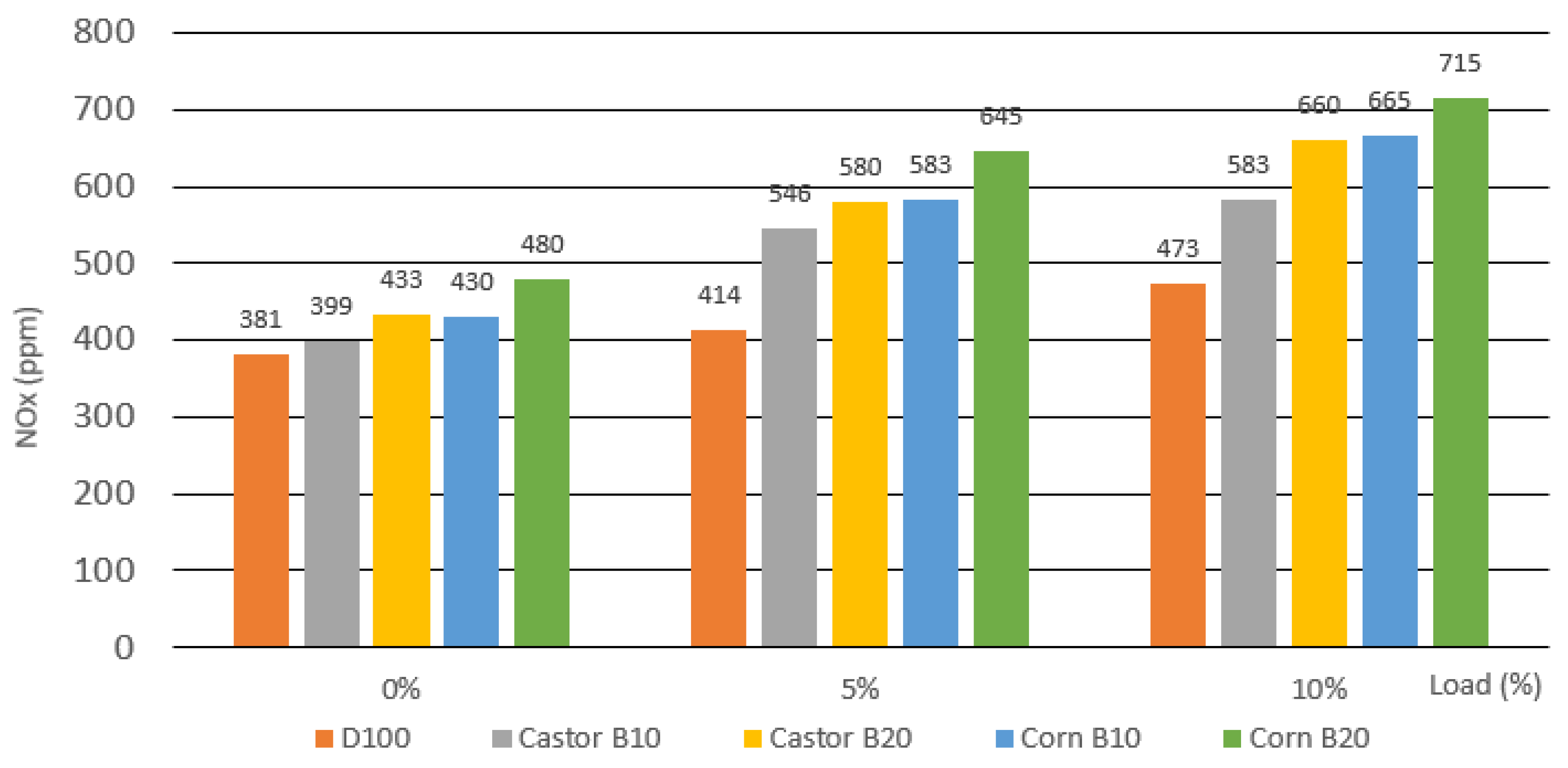
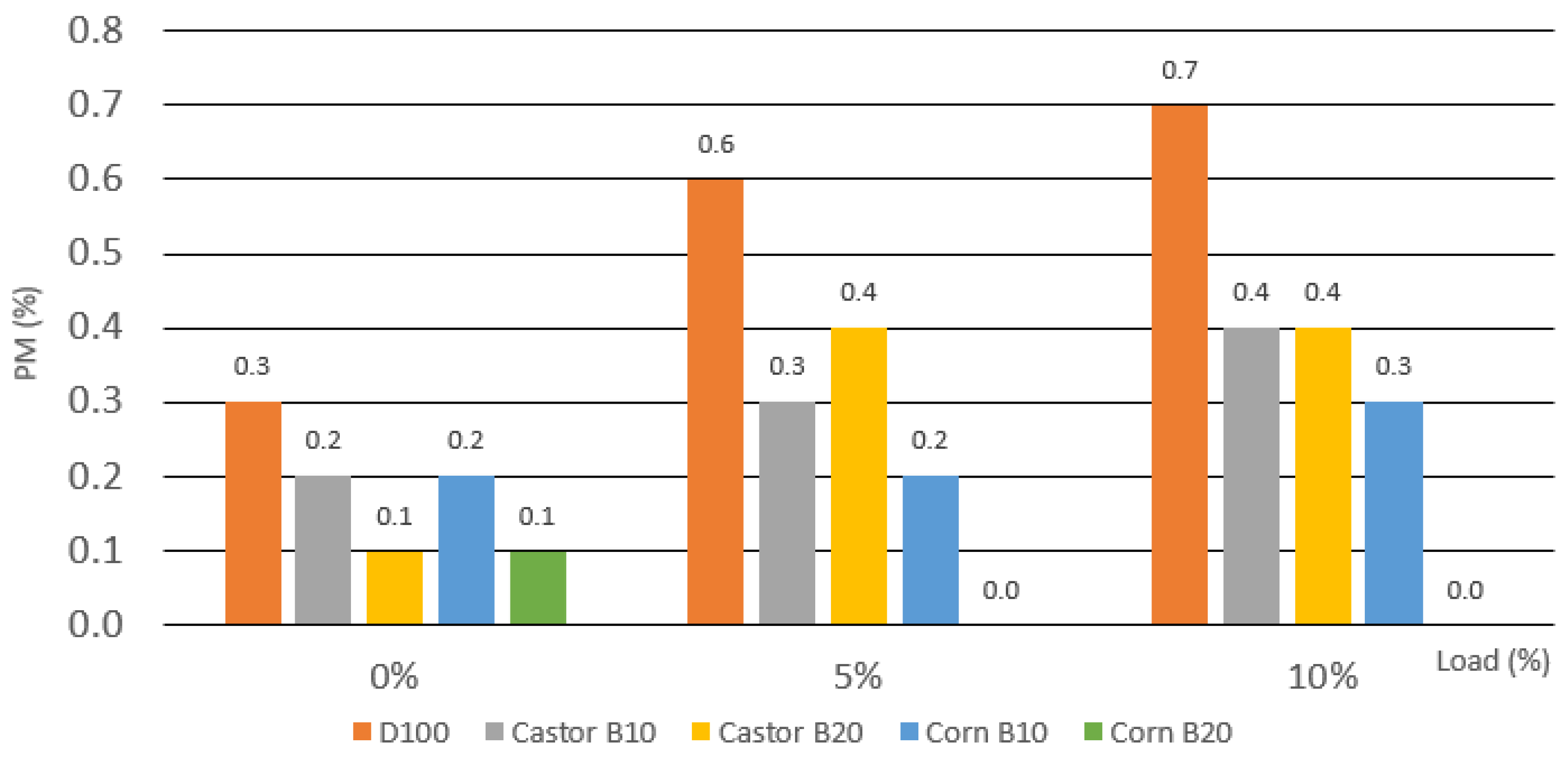
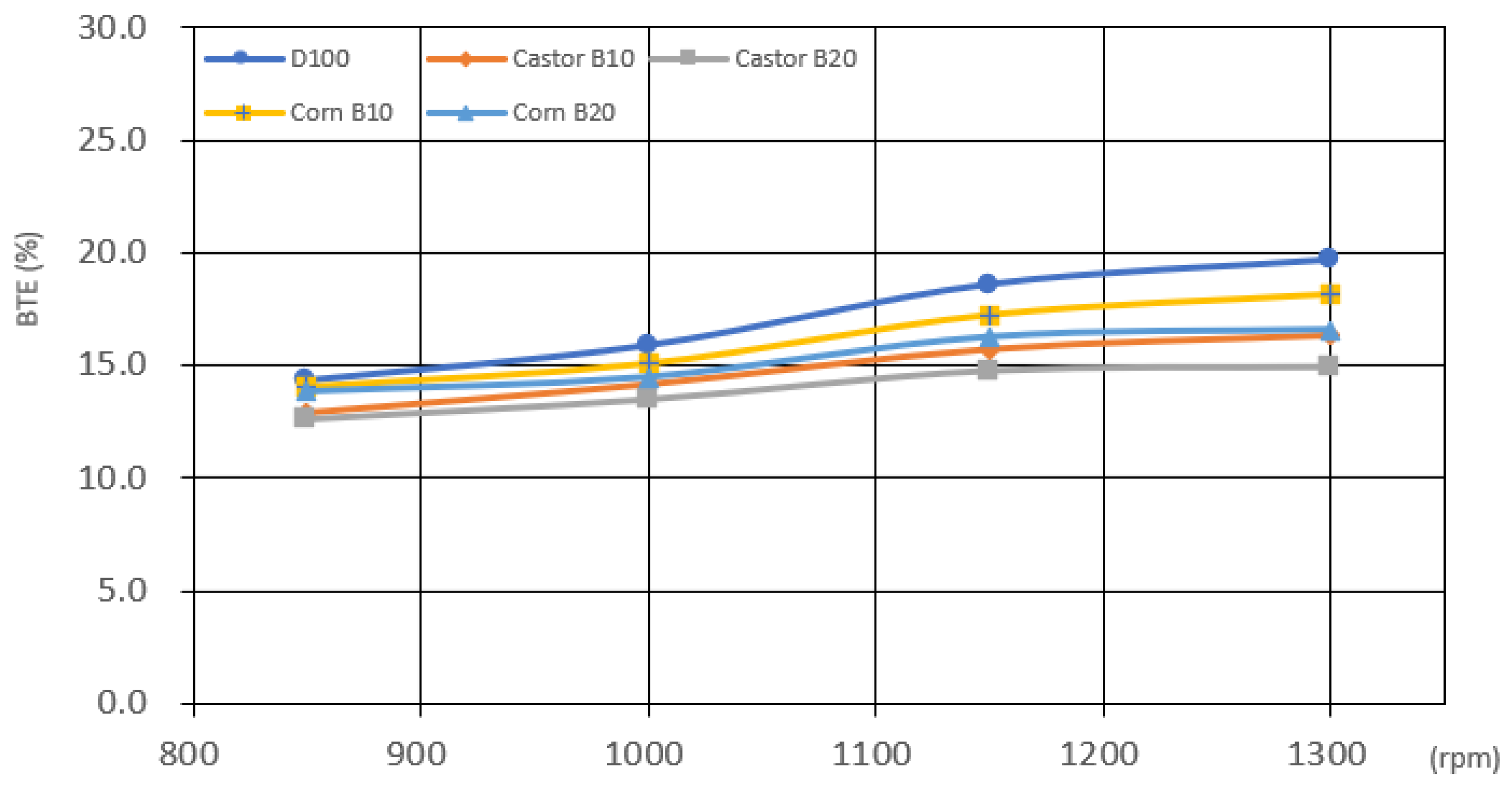

| Parameter | Specification |
|---|---|
| Using fuel | Diesel |
| No. of cylinders | 4 (inline) |
| Bore × Stroke | 84 × 90 mm |
| Displacement | 1995 cc |
| Fuel injection | Common rail direct injection |
| Valve type | DOHC |
| Injector type | Magnetic solenoid |
| Compression ratio | 16.0:1 |
| Max. fuel pressure | 1800 bar |
| Max. Power | 186 PS/4000 rpm |
| Max. Torque | 41 kgf-m/1750–2750 rpm |
| Emission Level | EURO5 |
| Emission Analyzer | Smoke Meter | |
|---|---|---|
| Measuring | HC, CO, CO2—NDIR | Light transmission |
| Principle | O2, NOx—Electrochemistry | smoke meter |
| Measurement | HC: 1~15,000 ppm, | 0.0~100.0% |
| Range | CO: 0.000~9.999% | |
| NOx: 0~5000 ppm, | ||
| O2: 0.00~25.00% | ||
| Accuracy | FS ±2% | ±1% (0.00~21.42 m−1) |
| Property | Standard (ASTM) | Diesel (D100) | Castor (B100) | Castor (B20) | Castor (B10) | Corn (B100) | Corn (B20) | Corn (B10) |
|---|---|---|---|---|---|---|---|---|
| Density (kg/m3) | 800–880 | 830 | 885 | 861 | 852 | 879 | 858 | 849 |
| Kinematic viscosity (mm2/s) | 1.9–6 | 2.43 | 8.46 | 5.92 | 4.08 | 7.26 | 4.68 | 3.78 |
| Cetane num. | 48–65 | 49.3 | 61.2 | 58.4 | 56.3 | 63.2 | 56.4 | 53.9 |
| Flash point (°C) | >130.0 | 54.0 | 109.0 | 90.2 | 78.2 | 79.1 | 66.7 | 61.5 |
| Calorific value (MJ/kg) | >35.0 | 45.1 | 35.2 | 39.8 | 41.9 | 38.4 | 40.4 | 42.1 |
Disclaimer/Publisher’s Note: The statements, opinions and data contained in all publications are solely those of the individual author(s) and contributor(s) and not of MDPI and/or the editor(s). MDPI and/or the editor(s) disclaim responsibility for any injury to people or property resulting from any ideas, methods, instructions or products referred to in the content. |
© 2024 by the authors. Licensee MDPI, Basel, Switzerland. This article is an open access article distributed under the terms and conditions of the Creative Commons Attribution (CC BY) license (https://creativecommons.org/licenses/by/4.0/).
Share and Cite
Lee, K.; Cho, H.M. Effects of Castor and Corn Biodiesel on Engine Performance and Emissions under Low-Load Conditions. Energies 2024, 17, 3349. https://doi.org/10.3390/en17133349
Lee K, Cho HM. Effects of Castor and Corn Biodiesel on Engine Performance and Emissions under Low-Load Conditions. Energies. 2024; 17(13):3349. https://doi.org/10.3390/en17133349
Chicago/Turabian StyleLee, Keunsang, and Haeng Muk Cho. 2024. "Effects of Castor and Corn Biodiesel on Engine Performance and Emissions under Low-Load Conditions" Energies 17, no. 13: 3349. https://doi.org/10.3390/en17133349





